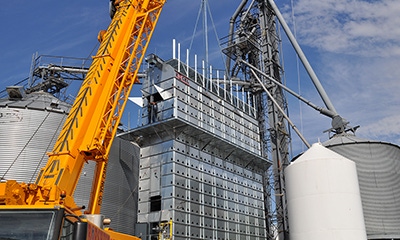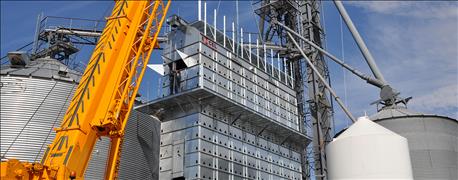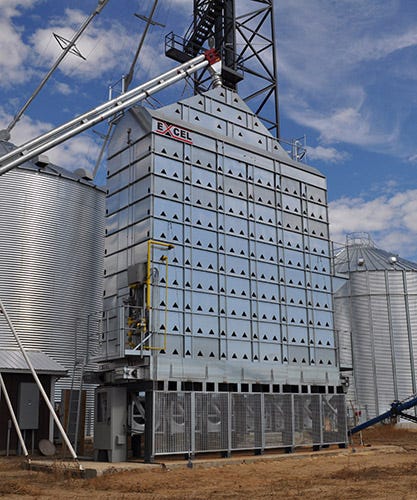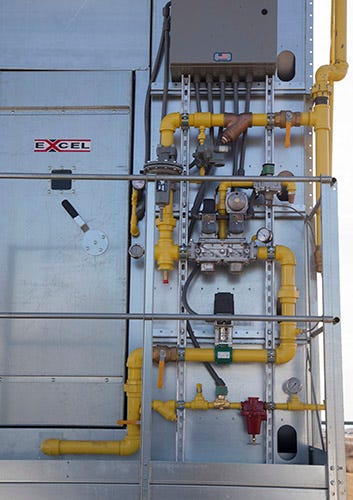August 26, 2015

With grain prices so low, cost-cutting measures take higher priority than usual. What can be trimmed or eliminated? What can be done more efficiently? Grain dryers are a good place to start trimming because they can pull a lot of unnecessary energy.

EXPANSION: Expanding a grain dryer to increase its capacity is as easy as adding more tiers when you have a continuous mixed flow under fan model.
Selecting a new grain dryer may be the answer to significantly reducing the farm's fuel consumption and keeping the energy budget in the green, says Rodie Jelleberg, customer service manager for Superior Manufacturing Co. He has been with the company for over five years and regularly meets with current and potential customers to provide grain handling solutions. Since Superior purchased EXCEL grain dryers three years ago, Jelleberg has taken an active role in research and development and was the key designer for the gas train and electrical system.
"Thorough research helps determine which dryer will best suit each operation long before pouring a concrete pad," notes Jelleberg. "Consider grain quality, energy efficiency, minimal maintenance, easy expansion capabilities and safety features, which all contribute to one objective: reaching the highest return on investment." He offers the following information and observations.
Dryer design: mix it up or cross it over?
Growers tend to rely on one of two dryer designs in an effort to consistently dry their grain for the highest bushel payment. Cross-flow dryers are the most widely used continuous flow dryers. Typically found in a tower dryer, this drying method uses a central heating chamber in the middle of the unit, and the grain fills in around the burner.

ENERGY EFICIENCY: Mixed-flow grain dryers use about half the energy of conventional screen dryers, and with capabilities ranging from 735 to 7,500 bushels per hour, they can fit small family farms or large commercial operations.
Its high temperatures work to dry grain quickly by forcing the hot air through the grain from the inside out. While effective at drying grain quickly, tower dryers tend to be less consistent due to the heating design, with kernels near the heater becoming overdried, and those near the wall being underdried.
In contrast, mixed-flow dryers heat grain more slowly, but at equal, consistent rates that reduce the potential for stress cracking. Heat is pushed through alternating rows of heat and exhaust ducts, conditioning the grain from both sides to keep it the same temperature throughout the process. The consistent, tempered heat from the under fans ensures that grain isn't underdried or overdried.
~~~PAGE_BREAK_HERE~~~

KEEP SAFETY IN MIND: Select a dryer with key safety features, such as a true-piloted gas train, to prevent the dryer from filling with propane.
Power down energy costs
Beyond considering time and grain quality, fuel efficiency plays a key role in getting the best ROI. For example, continuous mixed-flow dryers require significantly less energy to operate than a tower dryer, but generally have a higher price tag upfront. Growers will notice a faster return on investment with the mixed-flow dryer, which is 10% to 20% better than a cross-flow tower dryer for fuel efficiency, according to the Farmstead Energy Audit by North Dakota State University Extension Service.
Another consideration for growers when choosing the best dryer for a strong ROI are various farm grants available. For example, the Rural Energy for America Program with USDA Rural Development, can offset initial dryer costs by as much as 25% to 40%. Work with the equipment dealer, manufacturer or local USDA office to learn more about eligibility options. Ideal candidates are those struggling with worn out or inefficient equipment. Typically, this requires completing an energy audit, which includes gathering statistics on how much energy was saved after switching to a new unit.
Plan to be on the grow
It's also important to not be shortsighted when choosing a new dryer. How many bushels are dried with the current operation, and will the same size dryer fit needs in five years? Consider how easy it may be to expand a dryer as the farm grows.
For a tower dryer, growers can select the model needed and then, months or years later, add modules to dry more grain bushels on the farm. Once ready, this requires purchasing numerous components to complete the expansion. For example, a fan, heater controls and burner must be added in addition to the new modules.
With the mixed-flow dryer, growers can work with the manufacturer to equip the dryer with motors and electrical components required for the most tiers that would be needed. For example, growers can start with 10 tiers, for a 1,400-bushel capacity, but select the motor and electrical components suited for a 26-tier unit. This significantly reduces the cost and time spent to upgrade the dryer later.
Don't get burned
Everybody knows how dangerous dryers can be; that's why it's critical to select a dryer with safety features that prevent fires as well as reduce risk of injury and machine damage. Look for a dryer that features a true-piloted gas train, which prevents the pilot light from reigniting when the main flame goes out, which could cause the dryer to fill with gas and potentially cause an explosion.
~~~PAGE_BREAK_HERE~~~
Consider also choosing a flame rod rather than a UV sensor for the most accurate flame readings. The flame rod converts energy from the pilot flame into an electrical signal, but UV detectors can misinterpret reflected sunlight as the pilot flame. The false alarm causes the burner to open and the dryer to fill with flammable propane gas.
Check with the manufacturer that the dryer also comes equipped with a liquid gas regulator that ensures a dryer's vaporizer doesn't get overloaded with propane, which can foul the air and waste fuel. Also, look for a dryer manufacturer with a design that specifically prevents hot spots from developing in the unit. The concentrated heat of tower dryers allows fast drying, but it can cause material smoldering. Mixed-flow dryer designs use greater airflow coupled with corner openings to prevent hot spots.
Send downtime down the road
Growers have a seemingly endless amount of tasks on the farm. It's good to know some things can be simple. From easy to replace parts to fewer cleaning steps, dryer downtime can be minimized with a mixed-flow design.
Tower dryers need routine screen monitoring because corn chaff builds up in the screens. While the screens prevent "bee's wings" from damaging the fans and heaters, downtime for cleaning each week delays drying cycles. Mixed-flow dryers handle chaff by using the airflow to push it out the corner venting.
Prevent additional downtime by choosing designs with easily accessible components.
Consider whether the serviceable components can be reached without using a ladder. For example, a mixed-flow design places the gas train at eye level on the platform.
Additionally, find the balance between maximizing technology and ensuring easy serviceability on control panels. Some tower dryers use a programmable logic controller with an easy-to-operate touchscreen interface and remote mobile monitoring from a tablet, computer or smartphone. While the user-friendly interface enhances convenience, it can result in extensive downtime if it fails since trained technicians and specialized components will be needed for repairs. Some mixed-flow dryer manufacturers build controls with off-the-shelf components that can be easily replaced after a quick stop at the local electrical supply house. Speak with the manufacturer to verify the control panel type and ensure you never have to wait for a component to be manufactured or shipped.
~~~PAGE_BREAK_HERE~~~
Tough times call for good decisions
While low grain prices might seem like the time to avoid new equipment purchases,
that's not always the case. Some investments can save money and increase profit in the long run. It all comes down to evaluating your operational needs and matching those to the dryer size and design that will give you the best quality grain drying for the highest bushel prices and the least amount of energy expenses.
It never hurts to consider safety factors and features that can save time down the road in preventative maintenance and repairs, too. When that's done, it's easy to rest assured that expenses have been trimmed for the slim times and will help make even greater profits when bushel prices increase again.
Prepare your dryer for harvest
When it's time to get the dryer fired up for this year's harvest, be sure to complete a maintenance check-up. Just like a pickup truck, routine maintenance ensures all the components are in top working order for smooth operation. Here are four key tasks to complete before harvest:
1. Open each drop-down door and remove debris with a pressure washer or air compressor.
2. Check the quality of the fan motor belts for cracks or fraying. Replace if excessively worn.
3. Ensure proper fan belt tension, and check it periodically as under- and over-tensioned belts cause premature failure.
4. Lubricate the bearings on the drag conveyors and fan motors and replace bearings, if necessary.
"With just a few maintenance procedures, the dryer will be ready to go," says Jelleberg.
You May Also Like




